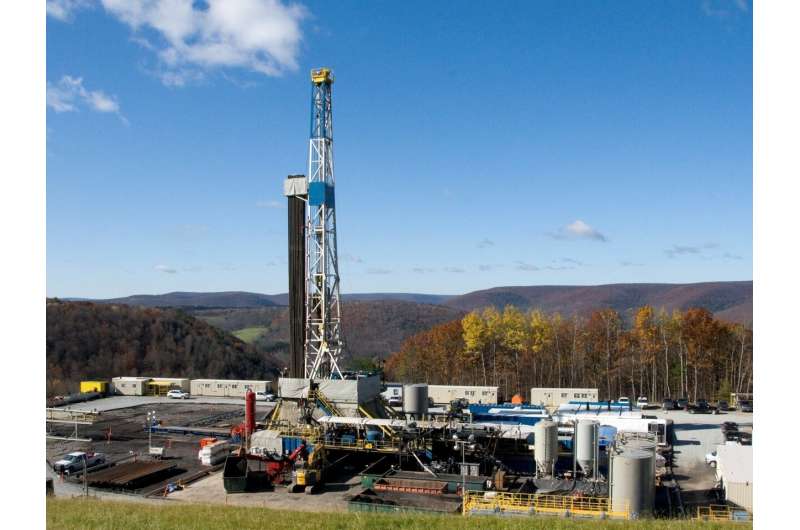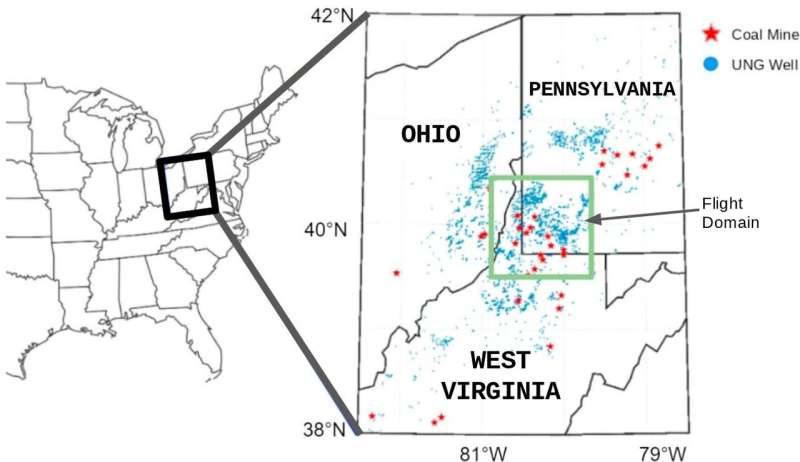Measuring methane from coal and gas in Pennsylvania informative

While methane pollution caused by natural gas production in Pennsylvania is underestimated by the U.S. Environmental Protection Agency, natural gas still has half the carbon footprint of underground coal mining, according to an international team of researchers.
"At the rates we found for methane, natural gas in Pennsylvania is still much, much cleaner than coal," said Zachary Barkley research associate in meteorology, Penn State. "Obviously, renewable energy would be better, but there is no debate, switching to natural gas is worth it in the short run."
The researchers looked at methane in the atmosphere by flying transects over the southwestern portion of Pennsylvania and adjacent portions of West Virginia and Ohio. Researchers from the University of Maryland collected data from the flights.
"The southwestern part of the state has huge amounts of natural gas and coal and we were getting methane from there during a previous project in northeastern Pennsylvania," said Barkley.
The southwestern area of Pennsylvania has long been a coal mining area and drilling into the Marcellus shale also has increased the numbers of unconventional natural gas wells in the area. The EPA estimates the amounts of methane put into the atmosphere from both coal mining and natural gas drilling every year.

Because both sources of methane exist in the same area, the researchers could not just measure methane and separate the sources. To determine the split between coal and natural gas, the researchers looked at the amounts of both methane and ethane and determined that more ethane is produced from natural gas wells, than from coal mines. They reported their results in a recent issue of Geophysical Research Letters.
Using the ratio of methane to ethane, the researchers found that the amount of methane released to the atmosphere from coal mines was very close to the EPA estimates, but that the amounts of methane from unconventional natural gas wells were between two to eight times the estimated EPA amounts. The EPA estimate is about 0.1 percent leakage, while the study found about 0.5 percent leakage. However, they note that because the wells in the Marcellus shale are such high-production wells, the net impact on climate of this natural gas production is still much lower than from coal mines after accounting for emissions from energy generation.
"High-producing wells have a much lower leakage rate than older wells which only produce 2 to 3 percent of Pennsylvania gas, but are estimated to produce about 40 percent of the state's total emission of methane from natural gas," said Barkley.

The researchers suggest that using the ratio of methane to ethane in other areas where emissions are from mixed sources could help to tease out the percentages of the carbon footprint from each source.
"Burning fossil fuel, whether coal or gas, is bad for the climate," said Kenneth J. Davis, professor of atmospheric and climate science, Penn State. "These underground coal mines are clearly more damaging than Marcellus gas production, but the gas production isn't as clean as we thought. We need more data like this to inform energy policy."
More information: Z. R. Barkley et al, Estimating Methane Emissions From Underground Coal and Natural Gas Production in Southwestern Pennsylvania, Geophysical Research Letters (2019). DOI: 10.1029/2019GL082131
Journal information: Geophysical Research Letters
Provided by Pennsylvania State University

















